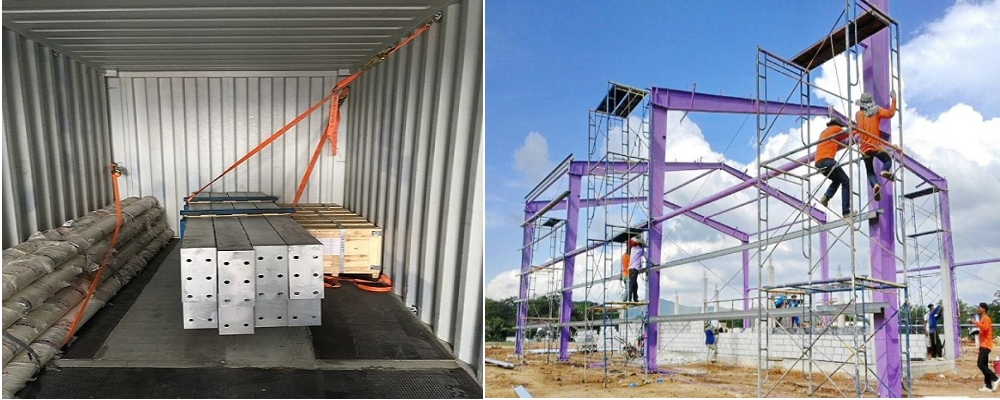Our Service
Desgin
The prefabricated Space Frame systems are composed of bar and node members which are designed to be fully pre-fabricated in our production facility and then to be erected at site.
The Space Frame elements are analysed according to the Matrix – Displacement Method. In the course of this analysis, the loads are applied only to the nodes. The bars are designed to respond to only axial tension or pressure. Loads; which might create a momentum or are perpendicular to the bars are not allowed to be applied to the bar. Should there exist such a load, it should be mentioned at the design phase and should be incorporated in the contract.
The static calculations are based on the loads which are obligatory and are used in all technical specifications (self load of the Space Frame, self load of the purlins, self load of the cladding, snow load, wind load, thermal loads, earthquake loads and the loads declared by the client and specified in the contract (functional loads, live load, service load, lighting, installations, air conditioning, suspended ceiling, catwalk, special loads with spot impact).
manufacturing
The surface of each part is entirely painted by a thin layer of 80 microns, smooth and bright pellicle. Then the sprayed parts are transferred into ovens at 200°C where they are kept until the required hardness of the powder coat is reached. The electrostatic powder coat has a longer life than the regular wet coatings or the coatings on-site because they are more resistent to strokes, temperatures ranging between ( –35°C) - ( +280°C), UV rays and erosion. The surface is smooth and without any blisters, flakes or stains.
The parts which can not be powder coated, can be coated with wet paint method with the approval of the principal. In this case, the wet paint can be applied in several layers until the coat thickness reaches 30 - 40 microns. Colors are chosen from the RAL catalogue and the finishing can be in dull, semi dull, bright or semi bright tones.
Nuts are hot-dip galvanised at 50 microns and the powder coat is applied on top. Nodes are electrogalvanised at 20 microns and the powder coat is applied on top. Bolts are electrogalvanised at 20 microns.
NodesThe joint nodes of the bar members are spherical in shape and manufactured of C45 steel by hot forging method which comply to the DIN EN 10083-1/-2/-3 norms. The number and the angles of the holes to be bored and threaded in each node are calculated separately for each project. The total number of holes per node shall be less then 18 holes.
Bars & Cones (Conical Tips)Bars are made of circular hollow section pipes with conical tips welded at each end. The function of the conical tips is to transmit the tensile and compressive forces. The bars and conical tips are produced of Steel grade ST 33 (S235), ST 44 (S275) or ST 52 (S355) complying with material norms DIN EN 17 100. Gas metal arc welding method is used for welding the conical tips to the pipes and the method complies with DIN 4100 and DIN 4115 norms. The bars are not completely enclosed and they have a functional hole at one end. The materials used in the projects are specified by appropriate material symbols.
Bolts, Nuts and Pins
The Bolts are functioning by means of conical tips welded at the pipe end. Before welding of the conical tip, the head of the bolt is inserted in the conical tip so that the head of the bolt remains inside of the pipe and the treaded part outside. Therefore, the conical tip lets the bolt rotate freely in every direction. The bolt had also a transversal orifice for pinning.
Nut is the hexagonal hollow section between the conical tip and the node element. The nut has two long orifices, one on each of its two symmetrical sides. The nut is mounted to the bolt, the pin is fixed into the bolts in such a way that its free ends are captured in the nut orifices and by the free rotation of these ends, the pins help the fixation of the bars to the nodes. The bolts are manufactured in conformity to DIN 267 requirements. ISO compiant threading processs is performed according to DIN 13.
Purlin Fixing Elements and Purlins
Purlin Fixing Elements
They are used to adjust the roof inclination and are fixed to the top holes drilled into the top cord nodes. These parts can be manufactured of pipe, of corner profile or a different section profile, depending on their functional requirements. Their dimension depends on the roof inclination.
Purlins
They are made of steel grade ST37 and their section can be C, U, Z or square hollow section profile, depending on the type of roof cladding.
Protection Against Corrosion
The corrosion protection is provided by the method of hot dip galvanization that is applied to Space Frame elements in conformity to EN ISO 1461. The life time of the hot dip galvanisation is between 10 - 20 years and this period can be extended considerably by the application of protection materials on the galvanised surface. However, in some cases, the hot dip galvanisation and powder coating methods can not be applied to certain components such as purlins, columns, supports etc. In this case, the hot dip galvanisation method is replaced by the spraying and powder coating.
Installation of all members is applied complying with the installation plan drawings where all the pipe and node members are stated with detail. Horizontal and low inclination pipes are always fixed in such a way that the orifices on the pipes are facing down. The purpose of this rule is to secure water drainage in case of humidity.
The bars are fixed to the nodes avoiding overstressing of the bolts and damage of threads. The bolts are fully screwed to the node element without leaving any space by the help of nuts. The installation can be done completely on the ground, or in the air, or partially on the ground and partially in the air.

Categories
Latest News
Contact Us
Contact: Mr.Lu
Phone: +86-51668601029
E-mail: hbktech@163.com
Whatsapp:86+15152106218
Add: 1412, Building 2, Vanke Huaihai Xintiandi, Block 3, Quanshan District, Xuzhou City, Jiangsu Province
